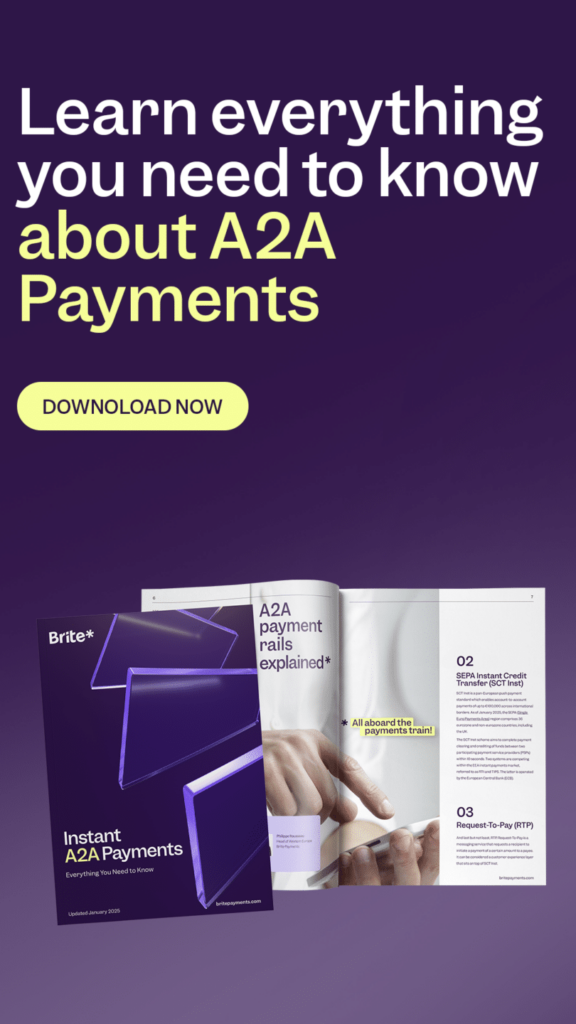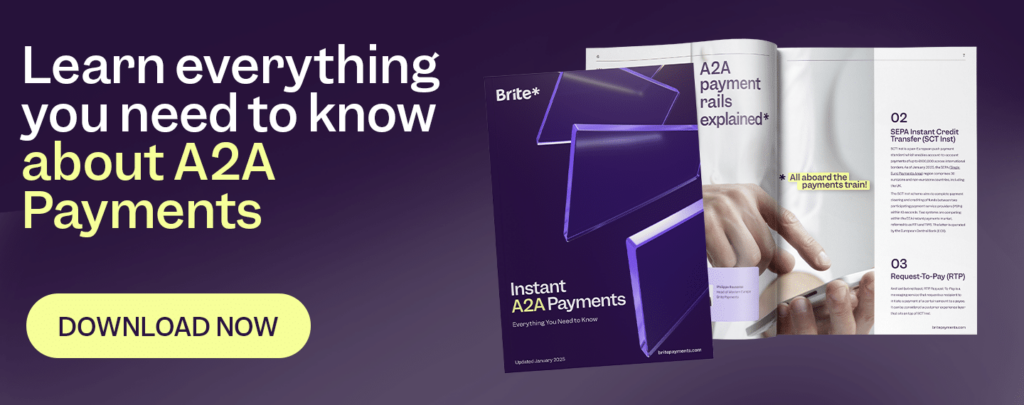
While open banking has been making waves in finance for years, one of its most exciting and practical uses is only just starting to hit the mainstream: open banking payments. A name which covers a range of payment types, many of which consumers across Europe may know well.
If you’ve seen a ‘Pay by Bank’ option at checkout, made a payment without entering card details, received a tax rebate much quicker, or received a refunded deposit faster than expected, you’ve likely already experienced it.
Powered by secure, regulated APIs, open banking payments move money directly between bank accounts, cutting out cards, intermediaries, and delays.
In this article, we’ll cover open banking payments, how they align with account-to-account (A2A payments) and instant payments, and their benefits for merchants and consumers.
Topics we’ll discuss include:
- What are open banking payments?
- How do open banking payments work?
- Open banking payments vs A2A payments – what is the difference?
- Are open banking payments instant?
- How open banking payments benefit businesses and consumers
What are open banking payments?
Open banking payments are payments made directly from one bank account to another, authorised by the payer via an open banking-enabled service. Currently, they appear to consumers in many different variations of name, with Pay by Bank (in Europe) proving to be one of the most popular and enduring.
Instead of cards or intermediaries like Visa/Mastercard, open banking payments use secure APIs regulated under open banking frameworks – e.g. PSD2 in Europe and the UK, which require banks to give licensed third-party providers access to customer accounts (with the customer’s permission).
The upcoming PSD3 regulation will further strengthen these standards, aiming to enhance security, improve customer protection, and expand the reach of open banking services across the region.
How do open banking payments work?
In four steps, here’s how open banking payments work:
- Pay by Bank selection
At the payment stage, whether online, in an app, or via a QR code, the customer typically chooses the Pay by Bank option (in markets such as Germany or the Nordics the naming may be different). This begins the open banking payment process where the transaction will be processed directly between bank accounts without using a card or entering bank details. - Redirection
Next, the customer is redirected to their bank’s app or website to authenticate the payment. This happens through a secure, regulated API connection that ensures the customer’s sensitive information isn’t shared with the merchant or payment provider. - Approval
Once inside their banking app or online account, the customer reviews the payment details, including the amount and the recipient, and confirms the transaction. This approval process is highly secure as it uses the customer’s own bank authentication methods, such as biometric ID (fingerprint or face recognition), a banking passcode, or a two-factor authentication code.
Open banking payments follow strict Strong Customer Authentication (SCA) requirements under PSD2, which means every payment must be verified using at least two of the following:
- Something the customer knows (like a PIN)
- Something they have (like their phone)
- Something they are (like a fingerprint)
These security standards are set to become even tighter with the introduction of PSD3, which will strengthen protections around customer authentication, data access, and fraud prevention across the EU and UK.
You might also be interested in: What Is Account Verification, and Why Does It Matter in Modern Payments?
- Transfer
After approval, the money is transferred directly from the customer’s bank account to the merchant’s account. In many cases, this happens instantly or within a few seconds, depending on the payment rails used (more on this later). The merchant receives immediate confirmation, and the transaction is complete.
Open banking payments vs A2A payments – what is the difference?
Open banking payments are direct transfers of money from one bank account to another without the involvement of card schemes or intermediaries like Visa, Mastercard, or PayPal.
In the payments industry, this method of moving money is commonly called account-to-account (A2A) payments. This broad category covers everything from traditional bank transfers to modern, API-driven payment methods.
What makes open banking payments different is how these A2A payments are initiated and authorised. At Brite, we call the type of A2A payments we offer instant A2A payments.
Open banking payments are enabled by regulated, secure APIs provided by banks under open banking frameworks like PSD2. These APIs allow third-party providers (with the customer’s consent) to connect to a customer’s bank account, initiate a payment, and securely redirect the customer to their bank for authentication.
You can think of open banking payments as the customer-friendly, modern interface for A2A payments. They simplify the process for both consumers and merchants by offering a seamless, mobile-first experience while relying on the core A2A infrastructure to move money directly between accounts.
Are open banking payments instant?
In many cases, open banking payments, such as instant A2A payments, are instant or near-instant. But as mentioned above, the speed of open banking payments depends on the payment rails—the underlying infrastructure that moves money between banks.
In Europe and the UK, open banking payments are made via SEPA Instant Credit Transfer, commonly referred to as SEPA Instant: a real-time payment scheme that allows euro-denominated payments to be transferred between participating banks across the SEPA (Single Euro Payments Area) network in less than 10 seconds, 24/7, 365 days a year.
With the EU’s Instant Payments Regulation coming into force in 2025, all banks in the Eurozone will soon be required to offer instant payments, which will give a further boost to open banking payment adoption in Europe.
Through direct integration with banks via APIs, open banking also allows payment providers – e.g. third-party providers like Brite – to offer additional services such as streamlined account aggregation, account verification for onboarding plus payment, and faster settlements.
This means that customers get their money instantly, and merchants also get their funds much quicker with fewer intermediaries.
How open banking payments benefit businesses and consumers
Open banking payments aren’t just a new way to pay: they deliver tangible benefits for both businesses and consumers.
For businesses, open banking payments bring:
- Lower transaction costs: Unlike card payments, which involve fees from multiple intermediaries, open banking payments move money directly between bank accounts. This removes costly middlemen, typically resulting in lower transaction fees – especially on high-value payments or recurring transactions.
- Faster settlement and improved cash flow: Because open banking payments settle instantly or within seconds, businesses can access funds in real time. Faster settlement improves cash flow management, reduces the need for working capital buffers, and shortens the time between sale and liquidity.
- Reduced fraud and chargebacks: Open banking payments are authorised directly by the customer via their bank using secure authentication methods like biometrics and two-factor authentication. This makes unauthorised transactions far less likely compared to card payments. Since payments are account-to-account, there are no chargebacks, which reduces operational risk and fraud-related costs.
Meanwhile, consumers get to benefit from:
- Simple, secure transactions: Open banking payments eliminate the need to enter long card numbers, expiry dates, or CVV codes. Customers simply select their bank, authenticate via their app or online banking, and approve the payment. It’s fast, familiar, and avoids sharing sensitive card information with merchants.
- Instant confirmation and peace of mind: Because funds move instantly or near-instantly, consumers receive immediate confirmation that their payment has been successfully sent. No waiting for authorisation or pending card holds; the money leaves their account and arrives at the merchant in real time.
- Greater control over authorising payments: Open banking puts customers in charge of each payment. Every transaction requires their explicit approval through their own bank’s authentication process, giving them complete visibility and control. It’s a seamless, mobile-first experience that offers extra confidence for users, especially for high-value or one-off payments.
In short, open banking payments are a fast, secure, and cost-effective way to move money directly between bank accounts, benefiting businesses and consumers alike.
Want to learn more about the benefits of open banking and instant A2A payments?
If you would like to know more about the benefits of open banking payments, particularly how you can combine instant payments with instant payouts, then get in touch with our payment experts today. Or if you would like to know more about instant A2A then download our explainer in the link below.

